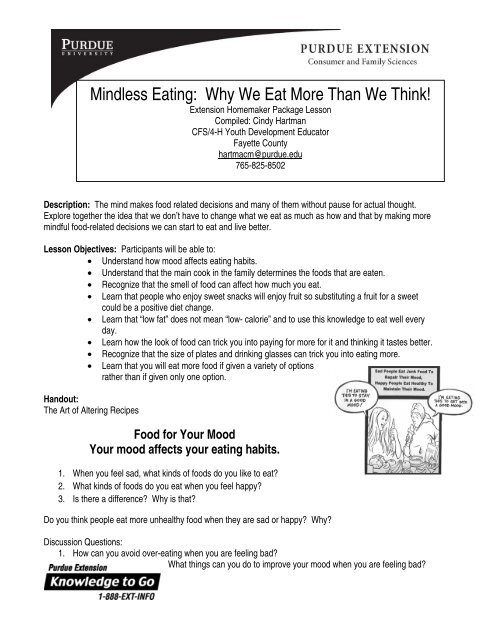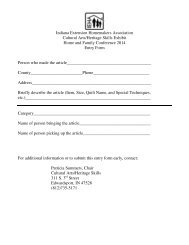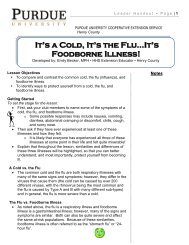Mindless Eating: Why We Eat More Than We Think! - IEHA-families.org
Mindless Eating: Why We Eat More Than We Think! - IEHA-families.org
Mindless Eating: Why We Eat More Than We Think! - IEHA-families.org
You also want an ePaper? Increase the reach of your titles
YUMPU automatically turns print PDFs into web optimized ePapers that Google loves.
<strong>Mindless</strong> <strong><strong>Eat</strong>ing</strong>: <strong>Why</strong> <strong>We</strong> <strong>Eat</strong> <strong>More</strong> <strong>Than</strong> <strong>We</strong> <strong>Think</strong>!<br />
Extension Homemaker Package Lesson<br />
Compiled: Cindy Hartman<br />
CFS/4-H Youth Development Educator<br />
Fayette County<br />
hartmacm@purdue.edu<br />
765-825-8502<br />
Description: The mind makes food related decisions and many of them without pause for actual thought.<br />
Explore together the idea that we don’t have to change what we eat as much as how and that by making more<br />
mindful food-related decisions we can start to eat and live better.<br />
Lesson Objectives: Participants will be able to:<br />
• Understand how mood affects eating habits.<br />
• Understand that the main cook in the family determines the foods that are eaten.<br />
• Recognize that the smell of food can affect how much you eat.<br />
• Learn that people who enjoy sweet snacks will enjoy fruit so substituting a fruit for a sweet<br />
could be a positive diet change.<br />
• Learn that “low fat” does not mean “low- calorie” and to use this knowledge to eat well every<br />
day.<br />
• Learn how the look of food can trick you into paying for more for it and thinking it tastes better.<br />
• Recognize that the size of plates and drinking glasses can trick you into eating more.<br />
• Learn that you will eat more food if given a variety of options<br />
rather than if given only one option.<br />
Handout:<br />
The Art of Altering Recipes<br />
Food for Your Mood<br />
Your mood affects your eating habits.<br />
1. When you feel sad, what kinds of foods do you like to eat?<br />
2. What kinds of foods do you eat when you feel happy?<br />
3. Is there a difference? <strong>Why</strong> is that?<br />
Do you think people eat more unhealthy food when they are sad or happy? <strong>Why</strong>?<br />
Discussion Questions:<br />
1. How can you avoid over-eating when you are feeling bad?<br />
What things can you do to improve your mood when you are feeling bad?
Take-Away Facts:<br />
1. While people tend to overeat unhealthy foods when they are sad, people who are happy often over-eat<br />
healthy foods.<br />
2. If you are feeling sad, don’t use food to try to improve your mood. Instead, try going for a walk,<br />
watching a movie, or talking to a friend.<br />
3. When feeling bad, many people overeat without realizing it. Put snacks into smaller bags to avoid<br />
eating too much.<br />
Activity- When do you eat these foods?<br />
Food Sad Mood Happy Mood<br />
Ice Cream<br />
Candy Bar<br />
Potato Chips<br />
Apple<br />
Raisins<br />
Other<br />
Who’s Your Food Gatekeeper?<br />
Over seventy percent of what you eat is determined by the main cook in your<br />
family .<br />
Take-Away Facts:<br />
1. The main cook in your house is responsible for the majority of what<br />
you eat.<br />
2. The main cook makes decisions (like using olive oil in place of<br />
butter) that affect the entire family.<br />
Discussion Questions<br />
1. Does the main cook in your family try to prepare dishes that the whole<br />
family will like? How could this be good? How could it be bad?<br />
2. What things could you do to help your family eat more nutritiously?<br />
3. What things would make you want to eat healthy foods?<br />
2
The Nose Knows Best<br />
The smell of a food affects how much of it you eat .<br />
1. How do you think apple pie would taste if you smelled onions while eating it? <strong>Why</strong>?<br />
2. How would you feel about eating lunch while sitting next to a smelly garbage can?<br />
Discussion Questions:<br />
1. How does the odor of a food affect how enjoyable it is to eat?<br />
2. How could you stop someone from wanting to eat a second helping of chocolate cake?<br />
3. If you ran a bakery what would you want your customers to smell when they came in?<br />
Take-Away Facts:<br />
1. If a food smells delicious, you will eat more.<br />
2. If a food smells strange, you will eat less.<br />
3. If you want to get people to eat more fruits, put out ripe, pleasant-smelling varieties.<br />
A Sweet Deal<br />
If you like sweet snacks, you will love fruit<br />
1. <strong>Think</strong> of some sweet snack foods you enjoy. What types of fruits could you eat instead?<br />
2. <strong>Why</strong> do you think many people don’t eat the recommended amount of fruit each day? What advice<br />
would you give them?<br />
Take-Away Facts:<br />
1. Fruit is a great alternative to sweet snacks.<br />
2. If you like to eat sweet foods, you will like to eat fruit.<br />
3. <strong><strong>Eat</strong>ing</strong> fresh fruit after dinner instead of a sugary dessert is a healthy change you can<br />
easily make.<br />
The Low-fat Lowdown<br />
“Low-fat” claims on foods can trick you into eating more.<br />
1. What comes to mind when you hear that a food is “low-fat”?<br />
2. Would you rather eat “low-fat” cookies or “regular” cookies? <strong>Why</strong>?<br />
3
Food Calories Regular Version Reduced Fat Version<br />
Fig Cookie 56 51<br />
Small Chocolate Chip Cookie 53 50<br />
Peanut Butter (2 TBS) 191 187<br />
Vanilla frozen yogurt (1 cup) 104 100<br />
Take-Away Facts:<br />
1. “Low-fat” foods do not necessarily have fewer calories than “regular” foods.<br />
2. Many people over-eat “low-fat” foods without realizing it.<br />
3. Even if they eat the same amount of calories, people feel less guilty about over-eating<br />
“healthy” foods (like granola) than “unhealthy” foods (like chocolate).<br />
4. <strong><strong>Eat</strong>ing</strong> all foods in moderation is one of the keys to a healthy lifestyle.<br />
Hey Good Lookin’!<br />
When food looks beautiful, we think it will taste better and we are<br />
willing to pay more for it<br />
Questions:<br />
1. When sitting down to a meal, what helps you decide whether the food you’re about to eat is going to<br />
taste good?<br />
2. If you wanted to impress guests at a meal, what kinds of things could you do to make your food seem<br />
tastier?<br />
3. Other than the look of a food, what other things affect your opinion of a food?<br />
4. If you wanted to help someone eat more healthy foods, how could you make the foods look tastier?<br />
Take-Away Facts:<br />
1. The more beautiful a food looks; the more delicious you think it is.<br />
2. Descriptive labels on foods increase sales by 27% and improve attitudes towards food (example –<br />
Black Forest Double Chocolate Cake vs. chocolate cake).<br />
3. People consider appearance more than taste when deciding how much a food is worth.<br />
Bottomless Bowls<br />
The amount of food you have left on your plate may trick you into<br />
eating more even after you are full.<br />
Questions:<br />
1. <strong>Think</strong> about dinner last night, when did you stop eating?<br />
4
2. Do you usually try to finish everything on your plate? <strong>Why</strong> or <strong>Why</strong> not?<br />
Discussion Questions:<br />
1. What types of situations could cause you to eat more than you would like to? How could you prevent<br />
from falling into these food traps?<br />
2. <strong>Why</strong> might eating until you finish everything on your plate not be the best idea?<br />
3. When you go to a fast food restaurant, how likely are you to get a drink refill? <strong>Why</strong> do you get the<br />
refill?<br />
Take-Away Facts:<br />
1. Fifty-four percent of American adults aim to finish everything on their plates. This behavior can lead to<br />
weight gain.<br />
2. Watch Out! Many people eat more food than they think. You can avoid doing this by putting a single<br />
serving of food on a plate (don’t eat directly from large bags/containers).<br />
3. People eat more food from large plates than they do off of small ones, but feel equally full. Therefore,<br />
use smaller plates!<br />
The Dark Side of Variety<br />
How variety causes you to overeat<br />
Questions:<br />
1. Explain why you think you would eat [more/less/the same amount]<br />
pudding if given both chocolate and vanilla to eat versus just one<br />
flavor.<br />
Discussion Questions:<br />
1. <strong>Why</strong> do you think variety causes people to eat more?<br />
2. What are some situations where having a greater variety would be beneficial? When would it be bad?<br />
Take-Away Facts:<br />
1. If a bag of trail mix is put in 20 bowls, people will think there is a greater variety than if the same amount was<br />
put into just a few bowls.<br />
2. When variety increases, people eat more. For example, when people were offered three different types of<br />
yogurt, they ate as much as 300% more than when offered only one type.<br />
3. Having a variety of foods available makes people think that they will enjoy the foods more.<br />
5
Did you know?<br />
Other Important Information<br />
1. For every 100 calories consumed you need to walk a mile.<br />
2. <strong>Mindless</strong> margin- if you remove or add (if you need to gain weight) 100-300 calories a day you would<br />
lose/gain10-30 pounds in a year.<br />
3. If you buy in bulk, repackage the food into serving size containers- you will be less likely to overeat.<br />
4. Hide the extras- if it is out of sight, you will be less likely to eat it.<br />
5. Use tape to seal the packages- making it harder to open. This will give you time to think if you really<br />
want/need to eat it.<br />
6. Dine with a friend; you will eat about 35% more. With a group of 7 or more you will consume 96%<br />
more food. If you are trying to lose weight, eat alone or with the smallest group possible, and pace<br />
yourself with the lightest eater.<br />
7. The longer that you sit a table the more you will consume.<br />
8. Preplate your food and you will eat about 14% less.<br />
9. Only put two items on your plate at a time at buffets.<br />
10. Always eat in the same room of your home but not in front of the television or computer. You won’t<br />
snack as much.<br />
11. Restaurant rules- enjoy 2 of these, but not all 3: an appetizer, a drink or a dessert. Share a dessert<br />
with a friend or ask for a take home box for the other half. Ask the waiter not to bring the bread or<br />
chips basket to your table.<br />
∗ Wansink, Brian, James E. Painter, and Jill North (2005). “Bottomless Bowls: <strong>Why</strong> Visual Cues of Portion Size<br />
May Influence Intake.” Obesity Research 13:1 (January), 93-100.<br />
Wansink, Brian, Ph. D., <strong>Mindless</strong> <strong><strong>Eat</strong>ing</strong>- <strong>Why</strong> <strong>We</strong> <strong>Eat</strong> <strong>More</strong> <strong>Than</strong> <strong>We</strong> <strong>Think</strong> (New York, Bantam Dell 2006).<br />
6
THE ART OF ALTERING RECIPES<br />
With the technique of altering some items in our recipes, we may just be able to “have<br />
our cake and eat it too”. Take a look at some of these ideas and incorporate them in<br />
your food choices and recipes that you prepare for both your family, pitch-ins and make<br />
them part of your daily lifestyle in terms of food preparation.<br />
o Select fewer foods that are high in fat, sugar and salt. Save foods like<br />
pastries, snack chips, cakes, cookies and candies for only special occasions and<br />
only have small portions when you eat these choices.<br />
o Choose whole grain breads and cereals for at least half of your grain choices.<br />
Use highly processed or refined cereals and breads only occasionally.<br />
o Take smaller portions. (Using a smaller plate makes portions appear larger –<br />
much of food perception is mental).<br />
o Modify recipes to decrease the amounts of fats, sugar and salt – increase the<br />
amount of fiber by replacing some or all of the white flour with whole grain<br />
flour.<br />
o Use more fresh fruits and vegetables.<br />
Here are some suggestions for making traditional recipes a healthier version:<br />
Remember that recipes are chemical formulas – they specify ingredients, proportions<br />
and methods necessary to produce a satisfactory product. Be aware that changes made<br />
to a recipe will produce a slightly different product than the original recipe. Experiment<br />
until you find a version that meets your satisfaction. Some recipes, such as soups and<br />
casseroles, are more flexible than others. Cake recipes are less adaptable than cookies<br />
but most recipes for baked goods can be altered – just remember that the taste and<br />
texture will vary from the original product.<br />
Know which ingredients can be altered: food scientists have found that most people<br />
don’t notice much difference or accept the difference that results when the following<br />
kinds of changes are made.<br />
o Reduce sugar by one-third – example: if a recipe calls for 1 cup, use 2/3 cup.<br />
This works best in canned and frozen fruits and in making puddings and custards.<br />
In cookies and cakes try using ½ cup sugar per cup of flour. For quick breads and<br />
muffins, use 1 tablespoon sugar per cup of flour. To enhance flavor when sugar is<br />
reduced, add vanilla, cinnamon or nutmeg.<br />
o Reduce fat by one-third- example: if the recipe calls for ½ cup use 1/3 cup. This<br />
works best in gravies, sauces, puddings and some cookies. For cakes and quick<br />
breads, use 2 tablespoons fat per cup of flour. Yogurt or cottage cheese may be<br />
substituted for sour cream in some sauce and dip recipes. Low fat cheeses can<br />
also be used in place of higher fat options. Skim milk may be substituted for<br />
whole milk. Evaporated milk or whipped nonfat dry milk may be substituted in<br />
place of cream in some recipes calling for whipped cream.<br />
o Omit salt or reduce by one-half – example: if the recipes says ½ teaspoon, use ¼<br />
teaspoon. This may be more acceptable if you gradually reduce the amount each<br />
time you make the recipe. Herbs, spices or salt-free seasoning mixes also can be<br />
used as flavor enhancers. Do not eliminate salt from yeast bread or rolls; it is<br />
essential for the flavor and helps texture.<br />
o Use whole grain and bran flours: whole wheat flour can replace from one-fourth<br />
to one-half of the all-purpose flour. Example: if a recipe has 3 cups all-purpose
flour, use 1½ cups whole wheat and 1½ cups all-purpose flour. Oat bran or<br />
oatmeal (that has been ground into flour or flour consistency) can replace up to<br />
one-fourth of the all-purpose flour. Example: if a recipe has 3 cups all purpose<br />
flour, use ¾ cup oat bran or ground oatmeal and 2¼ cups all-purpose flour. Bran<br />
cereal flour is made by grinding a ready-to-eat cereal such as Bran Buds or Fiber<br />
One or 100% Bran in a blender or food processor for 60 – 90 seconds. It can<br />
replace up to ¼ of the all-purpose flour. Example: if a recipe calls for 2 cups allpurpose<br />
flour, use ½ cup bran flour and 1½ cups all-purpose flour.<br />
Some other ideas:<br />
Instead of Try Best choice<br />
Butter 60/40 margarine – Margarine or reduced calorie<br />
butter blend<br />
margarine<br />
Sour cream Lite sour cream Mock sour cream<br />
2 whole eggs 1 whole egg plus 2 egg<br />
whites<br />
4 egg whites, commercial egg<br />
substitutes, or homemade egg<br />
substitute<br />
Whole milk 2 % milk Skim milk<br />
Cream Evaporated milk Evaporated skim milk<br />
Cottage cheese Lowfat cottage cheese Nonfat ricotta or cottage cheese<br />
Baking chocolate 3 tablespoons powdered cocoa plus 1<br />
tablespoon cooking oil<br />
Mayonnaise Lite mayonnaise Half cholesterol-free mayonnaise or<br />
nonfat yogurt<br />
Regular ground beef Lean ground beef Use extra lean ground beef or lean<br />
ground turkey (also try rinsing<br />
ground meat after cooking by using a<br />
sieve and hot water)<br />
Oil (1 cup) ½ cup baby fruit or veg. plus ½ cup<br />
oil or 1% buttermilk<br />
Nuts Use ½ the amount but toast to<br />
enhance the flavor





